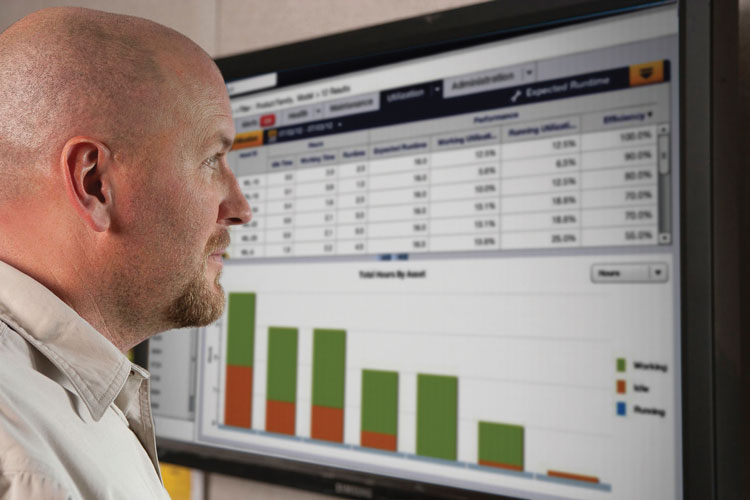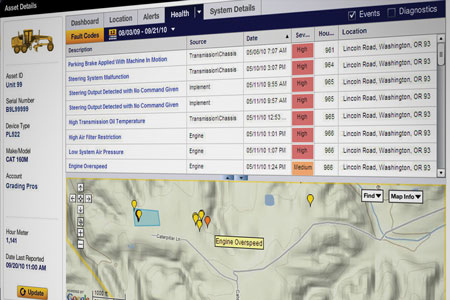The advancements in technology over the years has taken fleet management to a whole new level, allowing end users to make fact-based decisions when it comes to efficient fleet management.
By Clay Layne
What is fleet management? Simply put, it is the management of a company’s fleet of equipment. This includes a wide array of functions including, equipment financing, maintenance, telematics (tracking and diagnostics), operator management, fuel management, and health and safety management. Construction equipment fleet management allows companies to remove or minimize the risk associated with equipment investments, operator and equipment efficiency, productivity, and helping lower overall owning and operating costs. This can all be achieved by an in-house fleet manager or by an outsourced provider.
Fleet Management Challenges
- An effective fleet manager is not only tactical, but also business minded and tech savvy. As fleets grow, managers face more complex concerns, such as:
- Coping with information overload
- Integrating fleet data into existing software systems
- Making sure all assets are fully used
- Needing quick solutions to problems
- Finding specific fleet information quickly
- Software systems that are scalable and able to handle rapid growth
- Controlling unauthorized use of company assets
- The fleet manager with his/her unique insights into fuel efficiency, vehicle maintenance, operator/driver safety, federal and state regulations, and fleet expenses, is one of the most important drivers of your business.

and responsibly.
Photos courtesy of Caterpillar.
The Technology Revolution
Technology has revolutionized the industry. In the past, fleet management was extremely labor intensive. Managers were tasked with manually tracking each piece of equipment and all of its relevant information using a notebook or a whiteboard in their office. Tracking engine hours required personally going to each piece of equipment, logging information then transferring that data to wherever it was kept. Managers would then have the dauting task of analyzing all the information. They were required to inspect each piece of equipment one by one to determine what preventative maintenance was due. Then there was the manual task of getting those PMs assigned and scheduled piece by piece.
Fuel data was also monitored manually. Managers would have to log individual machines and compare the monthly hours to monthly gallons burned to determine fuel burn. If that was not enough, consider the machine alerts we take for granted today. Years ago, alerts did not exist or were extremely basic. The manager had no warnings that engine needed maintenance or had some other issues. Managers were at the mercy of the operator to provide necessary feedback and inform them of any potential issues. Costly problems may be avoided if they are identified early however, when the manager is unaware of a small problem it can escalate quickly. When small issues are ignored, there is a high probability that a major issue is on the way. Those major issues will likely cause additional downtime and higher repair costs. We all know time is money. It is easy to see how difficult the challenges were for managers to manually track and manage a fleet before the technology we have today.
Telematics
In today’s fleet management there is telematics. The use of this technology has the capability of enhancing the construction equipment fleet to a whole new level. Equipment telematics systems are used by equipment manufacturers and equipment users/owners for different purposes. Manufacturers use it increasingly to provide remote diagnostics for identification of mechanical or electrical problems or in general proper machine functions. Eighty percent of all OEMs (original equipment manuals) as well as dealers see telematics as a source of competitive advantage and anticipate the benefits from it like enhanced customer relationships and increased parts and service revenue.
Equipment owners or end users use it to obtain data about equipment. They can analyze data to help them determine if the machine is being used efficiently, productively and responsibly at their jobsites. This information is a vital tool as owners look to maximize revenue.
Telematics address the most critical challenges facing construction and rental equipment companies: increasing equipment use, reducing maintenance cost and increasing operational efficiency. Many OEMs have entered the field of telematics by providing products that are being enhanced every day.
Equipment fleet management data and report provisions, done by end users or renters of equipment or outsourced to a service company typically entails tracking the following types of data:
- Tracking of equipment hours—Working versus idling, equipment GPS location (by jobsite or virtual fences) security, low fuel warnings
- Dashboard Alerts—Tracking work levels/fuel use, view total fuel consumed, time spent moving machine versus using machine
- Track machines function—This information is available by internet alerts as well as e-mailed to managers
- Download information directly from the machine
- Maintenance reports
- Productivity reporting
- Critical machine health monitoring
- The benefits of fleet management using telematics are so comprehensive that thinking of how this was done prior to this technology is hard to imagine. Productivity and profitability are both improved by reducing cost and downtime. Equipment longevity is optimized by properly managing preventative maintenance schedules. Use and uptimes are maximized, decreasing costs. Customer service and satisfaction is elevated providing critical data from monitoring equipment health in a timely manner. Equipment data can also be integrated with customer systems for maximized efficiencies. This technology also provides valuable tracking, which reduces the risks of loss due to either theft or unauthorized use.

Critical Data
There are many different fleet management solutions on the market today created by many different OEMs. Websites have been developed where you can get access to all of your equipment data from any location, using any device and with a single login. There you will find critical data about all the machines you use, plus helpful tools to make your job easier—everything from PM schedules, parts and service records and inspection reports to info about rental contracts, warranty coverage, safety issues and more. Currently, there are Apps that allow you to complete everyday tasks without turning on your computer. They can give you the answers you need, right on your mobile device, whether it is around the jobsite, in your vehicle, even in your machine. Features can include:
- Track hours, location, fuel use, health and use: You can access this information daily. Fuel cost typically accounts for one third of your total operating cost. Being able to monitor fuel burn daily can help you reduce your overall fuel cost. Being able to look at hours will also help a fleet manager determine proper use of equipment.
- Request parts and service: Allows you to order parts or request a technician for repairs right from the field. This will help in minimizing downtime of your equipment.
- Receive health and maintenance alerts: This helps minimize downtime of equipment and reduces overall maintenance cost. Anytime an alert comes on the machine, an e-mail will be sent to the manager. This will allow the manager to get service right away to that machine. It also could be used as a training tool. If a manager continues to see the same alert repeatedly coming from the same operator, that could signal to the manager that the operator might need some additional coaching.
- Manage planned maintenance: The manager can check hours daily and know when routine maintenance is coming due. He can plan for it ahead of time and reduce loss of production due to maintenance.
- Connect with your dealer: Order service or parts in a timely fashion.
- Create and share tasks: The manager can put tasks out that he needs completed. This is fast and effective communication.
- Use your phone as a digital key: Your phone can replace the key for machine startup.
- Track driver and vehicle locations and routes: The advances in telematics and software as well as GPS mapping and route optimization software can not only simplify the life of a fleet manager, (it is easier to track vehicles and helps the drivers expedite their routes) but it can also save costs due to drivers getting lost, wasted fuel and lost delivery time.
- Report on driver safety behaviors with driver management: Fleet tracking systems can help you monitor speeding, harsh braking and rapid acceleration, and even idling—all which can wear and tear on a vehicle and cost you money in the long run.
There are also technologies that support asset tracking services, leveraging equipment telematics data and enabling customers to monitor their assets and more easily manage their fleet. Look for software systems that provide responses to the needs of customers and their specific daily challenges by focusing on the following areas:
Controlling Cost—Monitor and reduce idle time and fuel burn. Improve machine use and manage services to avoid downtime. Document working hours to increase resale value.
- Improving Operator Performance—Monitor operator performance to identify training opportunities. Compare individuals’ productivity and idle time numbers to motivate improvement.
- Running a Safe Operation—Know when unsafe actions occur, even from afar. Act quickly to prevent accidents and identify training opportunities.
- Increasing Production—Improve use by knowing if, when, where and how every asset is being used. Bid and schedule projects more accurately. Manage the entire jobsite via one interface.
A Whole New Level
The advancements in technology over the years has taken fleet management to a whole new level. When we think about how the fleet manager would have to physically visit each asset just to get the engine hours and in today’s world, we can get engine hours, idle hours, fuel burn, productivity and even order parts all from our phone. These advancements have allowed end users to make fact-based decisions when it comes to efficient fleet management. As we can see with all the telematic solutions, your jobsite assets have a story to tell. We must listen to that story. | WA
Clay Layne is the Waste Application Specialist with Caterpillar (Peoria, IL). He started working for Caterpillar in 2008 as an operator at the Peoria Proving Grounds working with Engineers on Research and Development of Caterpillar Machinery. In 2011, Clay moved to the Edwards Demonstration and Learning Center. It was here that Clay started working in the Waste Industry, conducting onsite operator training for Caterpillar customers all over the world. Clay can be reached at (309) 675-8486 or e-mail [email protected].
